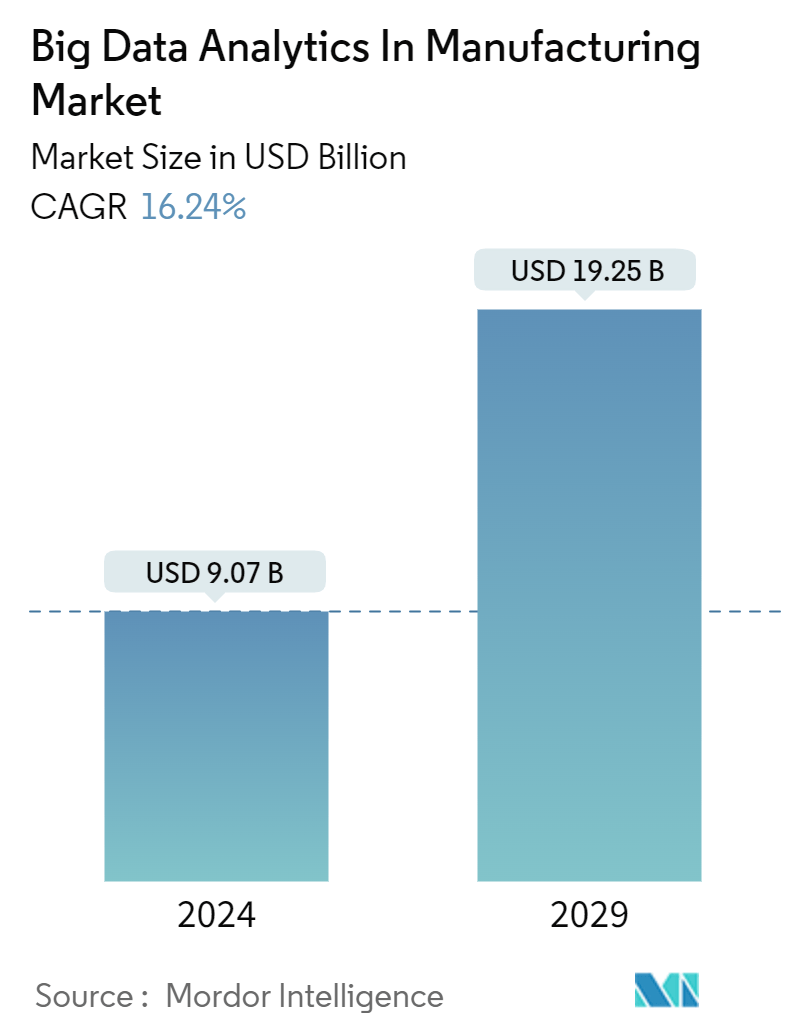Market Size of Big Data Analytics In Manufacturing Industry

| Study Period | 2019 - 2029 |
| Market Size (2024) | USD 9.07 Billion |
| Market Size (2029) | USD 19.25 Billion |
| CAGR (2024 - 2029) | 16.24 % |
| Fastest Growing Market | Asia Pacific |
| Largest Market | North America |
Major Players
*Disclaimer: Major Players sorted in no particular order |
Big Data Analytics In Manufacturing Market Analysis
The Big Data Analytics In Manufacturing Market size is estimated at USD 9.07 billion in 2024, and is expected to reach USD 19.25 billion by 2029, growing at a CAGR of 16.24% during the forecast period (2024-2029).
The primary factors driving the market’s growth include evolving technology, assets, engineering-oriented value chains, and rapid industrial automation led by Industry 4.0. The market sizing estimates reflect the revenue generated by the market vendors by offering big data analytics in manufacturing solutions to various end-users, such as semiconductors, aerospace, and automotive.
- Complex production processes, cross-company relationships in the supply chain, and constant pressure to avoid errors must be addressed by industrial manufacturers. Therefore, manufacturers need to expand their data sources so that costs can be reduced, the quality of products can be improved, and efficiency is increased. Companies using big data analytics improve key processes, eliminate bottlenecks, predict demand, and anticipate potential failures and delays.
- With the widespread use of connected devices and sensors, along with the enabling of M2M communication, there has been a significant increase in the data generated in the manufacturing industry. These data points can be of different types, from a metric detailing the time a material takes to pass through one process cycle to a more complex one, such as calculating the material stress capability in the automotive industry.
- Big data in manufacturing is increasing as manufacturers across the globe are seeing the benefits of integrating big data analytics in manufacturing across industries like oil and gas, automotive, food and beverages, refineries, plastics, and chemicals. Manufacturing companies are increasingly adopting big data analytics solutions to manufacture products and devices with high precision and accuracy. For instance, GE, known as the manufacturer of jet engines, locomotives, turbines, and medical imaging equipment, also develops smart, connected versions of the equipment in the massive data they generate.
- One of the factors hindering the growth of the market studied is the lack of digital skills and awareness to handle the unstructured data effectively for analysis. Big data security concerns are another major factor restraining the market adoption of industrial manufacturers.
- The COVID-19 pandemic disrupted several businesses but accelerated the shift to digitization in several sectors. In several regions that have been lagging in adopting digital technologies, manufacturers’ behavior in various sectors may have been permanently changed.
Big Data Analytics In Manufacturing Industry Segmentation
Big data analytics involves large data sets utilizing software and hardware technologies to produce significant insights for business growth. These processes use statistical analysis techniques like clustering and regression and apply them to more extensive datasets using newer tools. Data analytics is useful for real-time insights, process improvements, predictive maintenance, and others in the manufacturing industry. The development of high-speed networks and the Industrial Internet of Things has led to the development of intelligent sensors and devices interconnected with machine software and applications. These developments have led to a trend of connected factories that drive big data analytics.
In the manufacturing industry market, big data analytics is segmented into end-user industry (semiconductor, aerospace, and automotive), application (condition monitoring, quality management, and inventory management), and geography (North America (United States, Canada), Europe (United Kingdom, Germany, France, and Rest of Europe), Asia-Pacific (China, Japan, India, and Rest of Asia-Pacific), Latin America, and Middle East & Africa). The market size and forecasts are provided in terms of value (USD) for all the above segments.
| By End-user Industry | |
| Semiconductor | |
| Aerospace | |
| Automotive | |
| Other End-user Industries |
| By Application | |
| Condition Monitoring | |
| Quality Management | |
| Inventory Management | |
| Other Applications |
| By Geography | ||||||
| ||||||
| ||||||
| ||||||
| Latin America | ||||||
| Middle East and Africa |
Big Data Analytics In Manufacturing Market Size Summary
The Big Data Analytics in Manufacturing market is poised for significant growth, driven by advancements in technology and the rapid adoption of Industry 4.0 principles. This market encompasses the revenue generated from providing big data analytics solutions to various sectors, including semiconductors, aerospace, and automotive. The increasing complexity of production processes and the need for enhanced efficiency and quality are pushing manufacturers to leverage big data analytics. This technology enables companies to optimize key processes, predict demand, and anticipate potential failures, thereby reducing costs and improving product quality. The proliferation of connected devices and sensors has led to a substantial increase in data generation, further fueling the adoption of big data analytics across industries such as oil and gas, automotive, and chemicals.
In the automotive sector, big data analytics is transforming the industry by enabling more precise and accurate manufacturing processes. The integration of IoT and M2M communication is facilitating a shift towards a more data-driven approach, allowing for better planning and maintenance of assembly lines. The United States, with its early adoption of factory automation and a strong presence of technology providers, is a key player in this market. The automotive industry in Canada also plays a significant role, contributing to the region's manufacturing sector. Despite challenges such as a lack of digital skills and data security concerns, the market is expected to grow, supported by partnerships and innovative solutions from major players like Alteryx Inc., IBM Corporation, and Microsoft Corporation.
Big Data Analytics In Manufacturing Market Size - Table of Contents
-
1. MARKET INSIGHTS
-
1.1 Market Overview
-
1.2 Industry Attractiveness - Porter's Five Forces Analysis
-
1.2.1 Bargaining Power of Suppliers
-
1.2.2 Bargaining Power of Buyers
-
1.2.3 Threat of New Entrants
-
1.2.4 Threat of Substitutes
-
1.2.5 Competitive Rivalry within the Industry
-
-
1.3 Industry Value Chain Analysis
-
1.4 Assessment of the Impact of COVID-19 on the Industry
-
-
2. MARKET SEGMENTATION
-
2.1 By End-user Industry
-
2.1.1 Semiconductor
-
2.1.2 Aerospace
-
2.1.3 Automotive
-
2.1.4 Other End-user Industries
-
-
2.2 By Application
-
2.2.1 Condition Monitoring
-
2.2.2 Quality Management
-
2.2.3 Inventory Management
-
2.2.4 Other Applications
-
-
2.3 By Geography
-
2.3.1 North America
-
2.3.1.1 United States
-
2.3.1.2 Canada
-
-
2.3.2 Europe
-
2.3.2.1 United Kingdom
-
2.3.2.2 Germany
-
2.3.2.3 France
-
2.3.2.4 Rest of the Europe
-
-
2.3.3 Asia-Pacific
-
2.3.3.1 China
-
2.3.3.2 Japan
-
2.3.3.3 India
-
2.3.3.4 Rest of the Asia-Pacific
-
-
2.3.4 Latin America
-
2.3.5 Middle East and Africa
-
-
Big Data Analytics In Manufacturing Market Size FAQs
How big is the Big Data Analytics In Manufacturing Market?
The Big Data Analytics In Manufacturing Market size is expected to reach USD 9.07 billion in 2024 and grow at a CAGR of 16.24% to reach USD 19.25 billion by 2029.
What is the current Big Data Analytics In Manufacturing Market size?
In 2024, the Big Data Analytics In Manufacturing Market size is expected to reach USD 9.07 billion.

